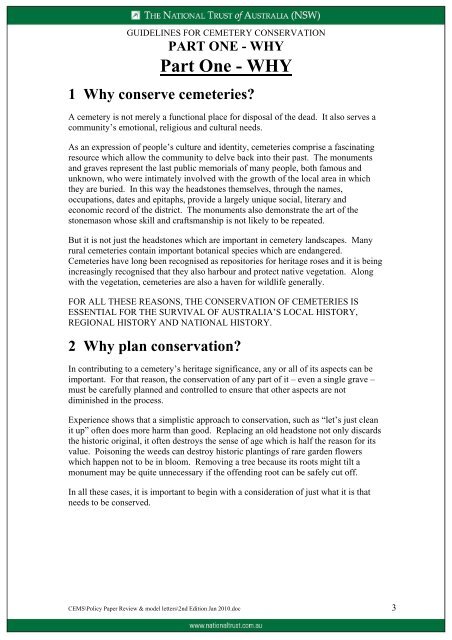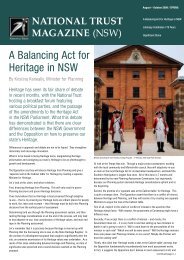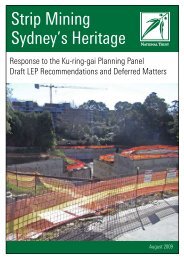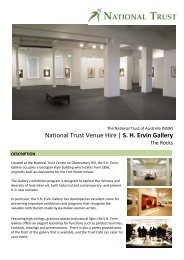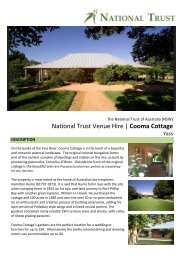Guidelines for Cemetery Conservation - National Trust of Australia
Guidelines for Cemetery Conservation - National Trust of Australia
Guidelines for Cemetery Conservation - National Trust of Australia
You also want an ePaper? Increase the reach of your titles
YUMPU automatically turns print PDFs into web optimized ePapers that Google loves.
GUIDELINES FOR CEMETERY CONSERVATION<br />
PART ONE - WHY<br />
Part One - WHY<br />
1 Why conserve cemeteries?<br />
A cemetery is not merely a functional place <strong>for</strong> disposal <strong>of</strong> the dead. It also serves a<br />
community’s emotional, religious and cultural needs.<br />
As an expression <strong>of</strong> people’s culture and identity, cemeteries comprise a fascinating<br />
resource which allow the community to delve back into their past. The monuments<br />
and graves represent the last public memorials <strong>of</strong> many people, both famous and<br />
unknown, who were intimately involved with the growth <strong>of</strong> the local area in which<br />
they are buried. In this way the headstones themselves, through the names,<br />
occupations, dates and epitaphs, provide a largely unique social, literary and<br />
economic record <strong>of</strong> the district. The monuments also demonstrate the art <strong>of</strong> the<br />
stonemason whose skill and craftsmanship is not likely to be repeated.<br />
But it is not just the headstones which are important in cemetery landscapes. Many<br />
rural cemeteries contain important botanical species which are endangered.<br />
Cemeteries have long been recognised as repositories <strong>for</strong> heritage roses and it is being<br />
increasingly recognised that they also harbour and protect native vegetation. Along<br />
with the vegetation, cemeteries are also a haven <strong>for</strong> wildlife generally.<br />
FOR ALL THESE REASONS, THE CONSERVATION OF CEMETERIES IS<br />
ESSENTIAL FOR THE SURVIVAL OF AUSTRALIA’S LOCAL HISTORY,<br />
REGIONAL HISTORY AND NATIONAL HISTORY.<br />
2 Why plan conservation?<br />
In contributing to a cemetery’s heritage significance, any or all <strong>of</strong> its aspects can be<br />
important. For that reason, the conservation <strong>of</strong> any part <strong>of</strong> it – even a single grave –<br />
must be carefully planned and controlled to ensure that other aspects are not<br />
diminished in the process.<br />
Experience shows that a simplistic approach to conservation, such as “let’s just clean<br />
it up” <strong>of</strong>ten does more harm than good. Replacing an old headstone not only discards<br />
the historic original, it <strong>of</strong>ten destroys the sense <strong>of</strong> age which is half the reason <strong>for</strong> its<br />
value. Poisoning the weeds can destroy historic plantings <strong>of</strong> rare garden flowers<br />
which happen not to be in bloom. Removing a tree because its roots might tilt a<br />
monument may be quite unnecessary if the <strong>of</strong>fending root can be safely cut <strong>of</strong>f.<br />
In all these cases, it is important to begin with a consideration <strong>of</strong> just what it is that<br />
needs to be conserved.<br />
CEMS\Policy Paper Review & model letters\2nd Edition Jan 2010.doc 3


